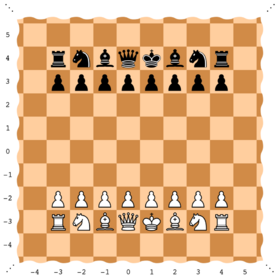Infinite chess
 From HandWiki - Reading time: 3 min
From HandWiki - Reading time: 3 min
Infinite chess is any variation of the game of chess played on an unbounded chessboard. Versions of infinite chess have been introduced independently by multiple players, chess theorists, and mathematicians, both as a playable game and as a model for theoretical study. It has been found that even though the board is unbounded, there are ways in which a player can win the game in a finite number of moves.
Background
Classical (FIDE) chess is played on an 8×8 board (64 squares). However, the history of chess includes variants of the game played on boards of various sizes. A predecessor game called courier chess was played on a slightly larger 12×8 board (96 squares) in the 12th century, and continued to be played for at least six hundred years. Japanese chess (shogi) has been played historically on boards of various sizes; the largest is taikyoku shōgi ("ultimate chess"). This chess-like game, which dates to the mid 16th century, was played on a 36×36 board (1296 squares). Each player starts with 402 pieces of 209 different types, and a well-played game would require several days of play, possibly requiring each player to make over a thousand moves.[1][2][3][4]
Chess player Jianying Ji was one of many to propose infinite chess, suggesting a setup with the chess pieces in the same relative positions as in classical chess, with knights replaced by nightriders and a rule preventing pieces from travelling too far from opposing pieces.[5] Numerous other chess players, chess theorists, and mathematicians who study game theory have conceived of variations of infinite chess, often with different objectives in mind. Chess players sometimes use the scheme simply to alter the strategy; since chess pieces, and in particular the king, cannot be trapped in corners on an infinite board, new patterns are required to form a checkmate. Theorists conceive of infinite chess variations to expand the theory of chess in general, or as a model to study other mathematical, economic, or game-playing strategies.[6][7][8][9][10]
Decidability of short mates
For infinite chess, it has been found that the mate-in-n problem is decidable; that is, given a natural number n and a player to move and the positions (such as on [math]\displaystyle{ \mathbb{Z} \times \mathbb{Z} }[/math]) of a finite number of chess pieces that are uniformly mobile and with constant and linear freedom, there is an algorithm that will answer if there is a forced checkmate in at most n moves.[11] One such algorithm consists of expressing the instance as a sentence in Presburger arithmetic and using the decision procedure for Presburger arithmetic.
The winning-position problem is not known to be decidable.[11] Not only is there a lack of an upper bound on the smallest such n when there is a mate-in-n, there are also positions for which there is a forced mate but no integer n such that there is a mate-in-n. For example, there is a position such that after one rook move by black, the number of moves until black is checkmated will be one more than the distance by which black moved.[12]
See also
- List of chess variants
- Fairy chess pieces
References
- ↑ Taikyoku Shogi.
- ↑ Chess Variants: Taikyoku Shogi.
- ↑ Abstract Strategy Games.
- ↑ Free History of Chess.
- ↑ Infinite Chess at The Chess Variant Pages. An infinite chess scheme represented using ASCII characters.
- ↑ "Infinite Chess, PBS Infinite Series" PBS Infinite Series.
- ↑ Evans, C. D. A.; Joel David Hamkins (2013). Transfinite game values in infinite chess.
- ↑ Evans, C. D. A.; Joel David Hamkins; Norman Lewis Perlmutter (2015). A position in infinite chess with game value ω4.
- ↑ Aviezri Fraenkel; D. Lichtenstein (1981), "Computing a perfect strategy for n×n chess requires time exponential in n", J. Combin. Theory Ser. A 31 (2): 199–214, doi:10.1016/0097-3165(81)90016-9
- ↑ "A position in infinite chess with game value w^4" Transfinite game values in infinite chess, January 2017; A position in infinite chess with game value w^4, October 2015; An introduction to the theory of infinite games, with examples from infinite chess, November 2014; The theory of infinite games: how to play infinite chess and win, August 2014; and other academic papers by Joel Hamkins.
- ↑ 11.0 11.1 Brumleve, Dan; Hamkins, Joel David; Schlicht, Philipp (2012). "The Mate-in-n Problem of Infinite Chess is Decidable". How the World Computes. Lecture Notes in Computer Science. 7318. Springer. pp. 78–88. doi:10.1007/978-3-642-30870-3_9. ISBN 978-3-642-30869-7.
- ↑ Evans, C. D. A.; Joel David Hamkins (2013). Transfinite game values in infinite chess. pp. Figure 3.
External links
- Infinitechess.org: Online implementation that supports play against the computer, against an opponent in the same room, or against an opponent on the internet.
- Infinite Chess at The Chess Variant Pages
 |
 KSF
KSF

